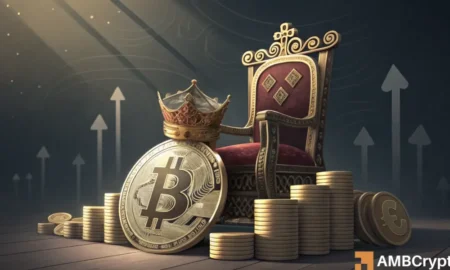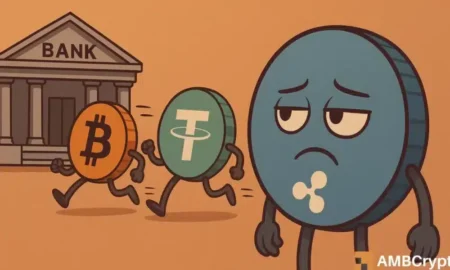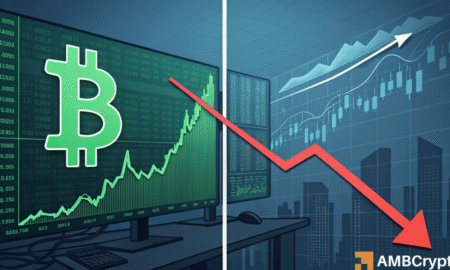The Current Ethereum Landscape: Analyzing Whale Activity and Retail Resilience
In recent weeks, Ethereum (ETH) has captured significant attention as large transactions among whales surged, revealing a potentially shifting market dynamic. Whale activity has displayed notable characteristics, including a remarkable 185% spike in transactions over $10 million, raising questions about the motivations behind these trades and their implications for the broader market. Nonetheless, the retail sector remains robust, indicating that despite the increasing presence of large players, everyday users continue to engage actively with the Ethereum network.
One prominent concern arose when an Ethereum Foundation-linked wallet made headlines after depositing 1,000 ETH—valued at approximately $1.58 million—into Kraken. This wallet had historically been poised for significant activity, obtaining over 84,000 ETH in the past decade when prices hovered around $1.20. Such movements raise eyebrows among market observers, particularly given that another whale recently divested 2,056 ETH at a price of $1,591 while simultaneously opening a 10x short position on Hyperliquid. These actions suggest a potential bearish outlook from influential market participants, prompting speculation on whether whales are bracing for a price correction while retail investors remain steadfast.
Transaction activity across the Ethereum network presents a mixed picture. While the substantial increases in high-value transactions indicate growing manipulation from larger entities, retail participants are also contributing to positive market dynamics. Transfers exceeding $1 million surged by over 64%, while the largest transactions experienced an astounding 185% increase. Interestingly, smaller transaction bands (ranging from $1 to $100) also showed resilience, with increases of 6.71% and 4.82%, respectively. These statistics underline the dual nature of the current market environment, wherein both whale activities and retail engagements coexist, showcasing Ethereum’s enduring appeal even amidst external pressures.
Evidently, Ethereum’s broader health is reflected in its user engagement metrics. The network’s fundamentals remain strong, as evidenced by a 13.93% rise in new address creation over the past week. This uptick signals greater onboarding activity and renewed interest among users. Furthermore, active addresses climbed by 3.09%, suggesting that existing Ethereum holders are not only retaining their assets but are also increasingly engaged with the network. An additional notable metric is the increase in zero-balance addresses—which rose by 8.82%—indicating that previously dormant wallets are returning to activity. These factors collectively convey a strong sentiment of confidence at the user level, suggesting that Ethereum maintains its foundational utility even while larger transactions reflect potential volatility.
However, the environment is fraught with complexities, particularly for long traders who may be overleveraged—a situation that could lead to significant market disruptions. Data from April 22 highlighted that long liquidations totaled a staggering $25.71 million, whereas short liquidations amounted to only $5.17 million. This disparity signals an overly optimistic sentiment among traders who may be ignoring bearish trends instigated by whale maneuvers and market volatility in derivatives. Importantly, the trading price of Ethereum stood at $1,584.44, down 3.71%, spotlighting the risk that a continuation of price declines could potentially trigger a wave of forced sell-offs among bullish positions.
As the market anticipates further developments, the future of Ethereum seems uncertain. Retail activity and network engagement signal a resilient belief in the asset’s long-term viability. However, large-scale exits by whales and a growing interest in short positions create a foundation of bearish sentiment among market influencers. The juxtaposition of these opposing forces raises critical questions: Can Ethereum sustain its current support levels? Or will it face downward pressure leading to a reevaluation of its price amidst potential selling pressure? Unless new institutional or retail demand emerges to counteract this mounting tension, Ethereum might struggle to remain in its current price range, increasing the likelihood of revisiting lower levels before stability can be achieved.
In conclusion, the Ethereum landscape remains intricate and multifaceted, characterized by contrasting actions between whale entities and retail traders. Despite spikes in whale transactions suggesting bearish market sentiment, the ongoing engagement from retail investors signifies an enduring confidence in Ethereum’s future. As the market navigates through this phase, it will be vital to observe how these dynamics unfold and influence the price trajectory of ETH in the coming weeks. For both retail and institutional investors, understanding the interplay between whale activities and grassroots engagement will be key to making informed decisions in this evolving ecosystem.
















